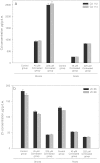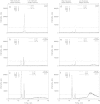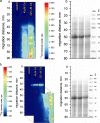The Influence of Cadmium Stress on the Content of Mineral Nutrients and Metal-Binding Proteins in Arabidopsis halleri
- PMID: 23002314
- PMCID: PMC3443489
- DOI: 10.1007/s11270-012-1292-4
The Influence of Cadmium Stress on the Content of Mineral Nutrients and Metal-Binding Proteins in Arabidopsis halleri
Abstract
We investigated the influence of cadmium stress on zinc hyperaccumulation, mineral nutrient uptake, and the content of metal-binding proteins in Arabidopsis halleri. The experiments were carried out using plants subjected to long-term cadmium exposure (40 days) in the concentrations of 45 and 225 μM Cd(2+). Inductively coupled plasma-mass spectrometry, size exclusion chromatography coupled with plasma-mass spectrometry, and laser ablation inductively coupled plasma-mass spectrometry used for ablation of polyacylamide gels were employed to assess the content of investigated elements in plants as well as to identify metal-binding proteins. We found that A. halleri is able to translocate cadmium to the aerial parts in high amounts (translocation index >1). We showed that Zn content in plants decreased significantly with the increase of cadmium content in the growth medium. Different positive and negative correlations between Cd content and mineral nutrients were evidenced by our study. We identified more than ten low-molecular-weight (<100 kDa) Cd-binding proteins in Cd-treated plants. These proteins are unlikely to be phytochelatins or metallothioneins. We hypothesize that low-molecular-weight Cd-binding proteins can be involved in cadmium resistance in A. halleri. ELECTRONIC SUPPLEMENTARY MATERIAL: The online version of this article (doi:10.1007/s11270-012-1292-4) contains supplementary material, which is available to authorized users.
Figures



Similar articles
-
Contrasting cadmium resistance strategies in two metallicolous populations of Arabidopsis halleri.New Phytol. 2018 Apr;218(1):283-297. doi: 10.1111/nph.14948. Epub 2018 Jan 2. New Phytol. 2018. PMID: 29292826
-
Metal accumulation in tobacco expressing Arabidopsis halleri metal hyperaccumulation gene depends on external supply.J Exp Bot. 2010 Jun;61(11):3057-67. doi: 10.1093/jxb/erq129. Epub 2010 May 19. J Exp Bot. 2010. PMID: 20484319 Free PMC article.
-
Do Arabidopsis halleri from nonmetallicolous populations accumulate zinc and cadmium more effectively than those from metallicolous populations?New Phytol. 2002 Jul;155(1):47-57. doi: 10.1046/j.1469-8137.2002.00432.x. New Phytol. 2002. PMID: 33873296
-
Hyperaccumulation of cadmium and zinc in Thlaspi caerulescens and Arabidopsis halleri at the leaf cellular level.Plant Physiol. 2004 Feb;134(2):716-25. doi: 10.1104/pp.103.031948. Epub 2004 Jan 15. Plant Physiol. 2004. PMID: 14730081 Free PMC article.
-
The use of the model species Arabidopsis halleri towards phytoextraction of cadmium polluted soils.N Biotechnol. 2012 Nov 15;30(1):9-14. doi: 10.1016/j.nbt.2012.07.009. Epub 2012 Jul 28. N Biotechnol. 2012. PMID: 22850245 Review.
Cited by
-
Interaction Between Cadmium Stress and Sulphur Nutrition Level on Macronutrient Status of Sinapis alba L.Water Air Soil Pollut. 2016;227(9):355. doi: 10.1007/s11270-016-3059-9. Epub 2016 Sep 1. Water Air Soil Pollut. 2016. PMID: 27682198 Free PMC article.
-
Cd and Cu accumulation, translocation and tolerance in Populus alba clone (Villafranca) in autotrophic in vitro screening.Environ Sci Pollut Res Int. 2018 Apr;25(10):10058-10068. doi: 10.1007/s11356-018-1299-5. Epub 2018 Jan 30. Environ Sci Pollut Res Int. 2018. PMID: 29380203
-
HvPAA1 Encodes a P-Type ATPase, a Novel Gene for Cadmium Accumulation and Tolerance in Barley (Hordeum vulgare L.).Int J Mol Sci. 2019 Apr 8;20(7):1732. doi: 10.3390/ijms20071732. Int J Mol Sci. 2019. PMID: 30965578 Free PMC article.
-
Remediation of Cadmium Stress in Strawberry Plants Using Humic Acid and Silicon Applications.Life (Basel). 2022 Nov 23;12(12):1962. doi: 10.3390/life12121962. Life (Basel). 2022. PMID: 36556327 Free PMC article.
-
Effects of amino acids on the germination and Cd accumulation in soybeans exposed to cadmium.Biometals. 2025 Aug;38(4):1337-1353. doi: 10.1007/s10534-025-00709-2. Epub 2025 Jun 18. Biometals. 2025. PMID: 40533709
References
-
- Abratowska, A., Wąsowicz, P., Bednarek, P., Telka, J., & Wierzbicka, M. (2012). Morphological and genetic distinctiveness of the metallicolous and non-metallicolous populations of Armeria maritima s. l. (Plumbaginaceae) in Poland. Plant Biology, 14, 586–595. - PubMed
-
- Bert V, Meerts P, Saumitou-Laprade P, Salis P, Gruber W, Verbruggen N. Genetic basis of Cd tolerance and hyperaccumulation in Arabidopsis halleri. Plant and Soil. 2003;249:9–18. doi: 10.1023/A:1022580325301. - DOI
LinkOut - more resources
Full Text Sources
Research Materials
